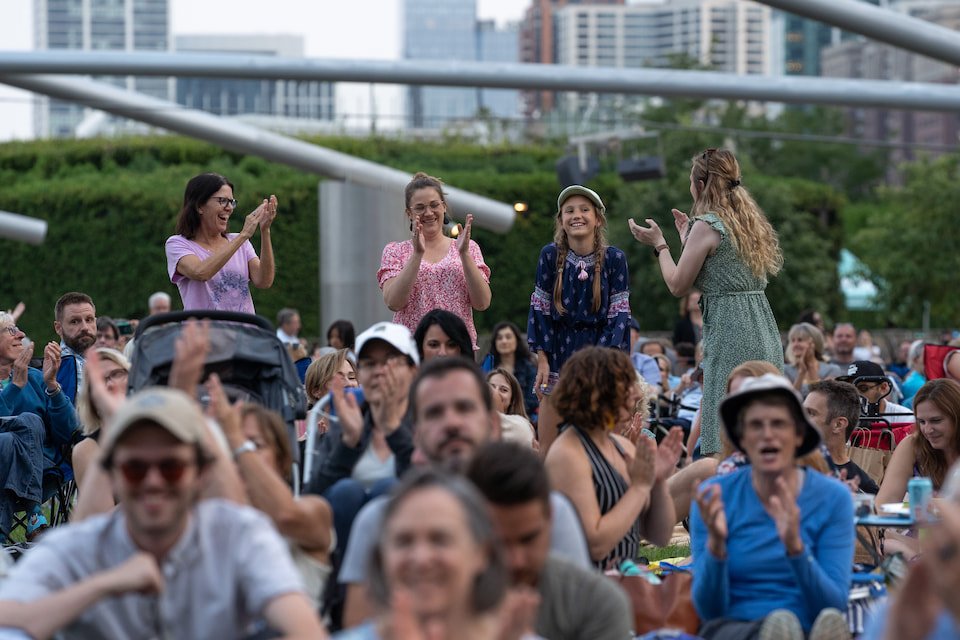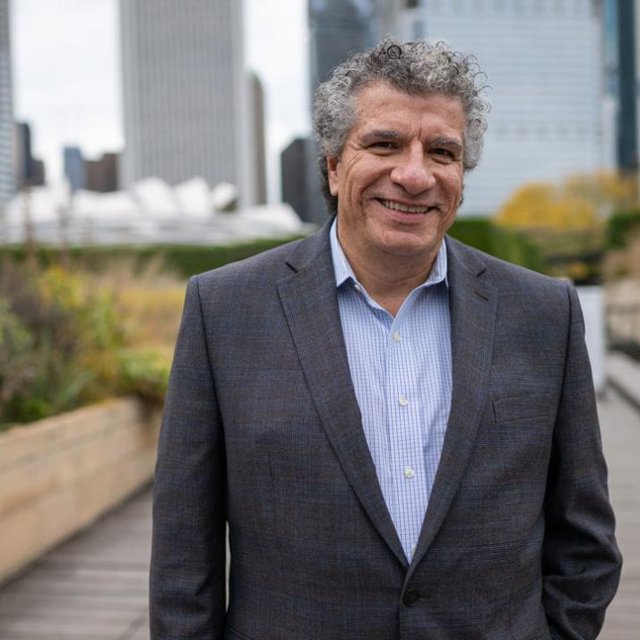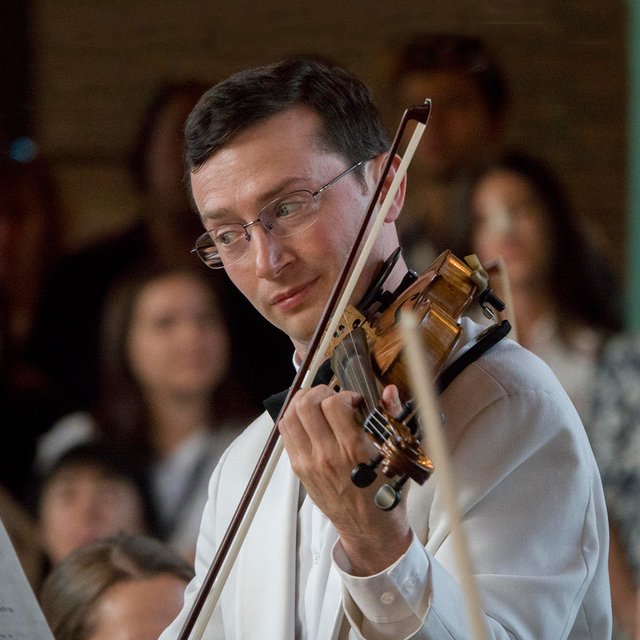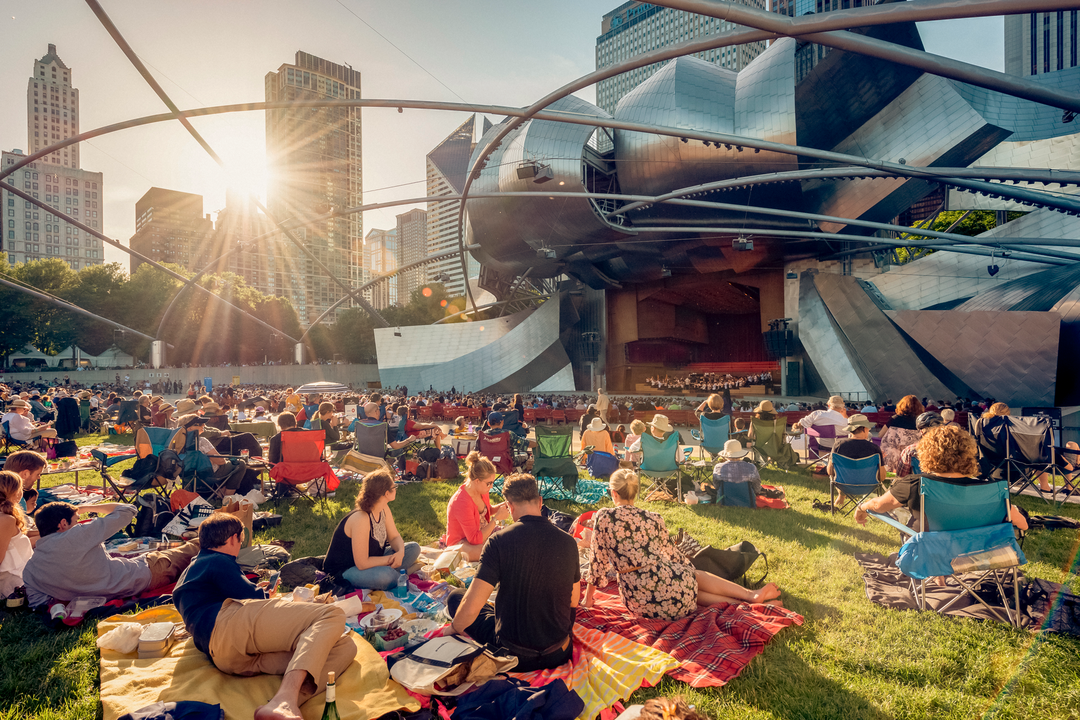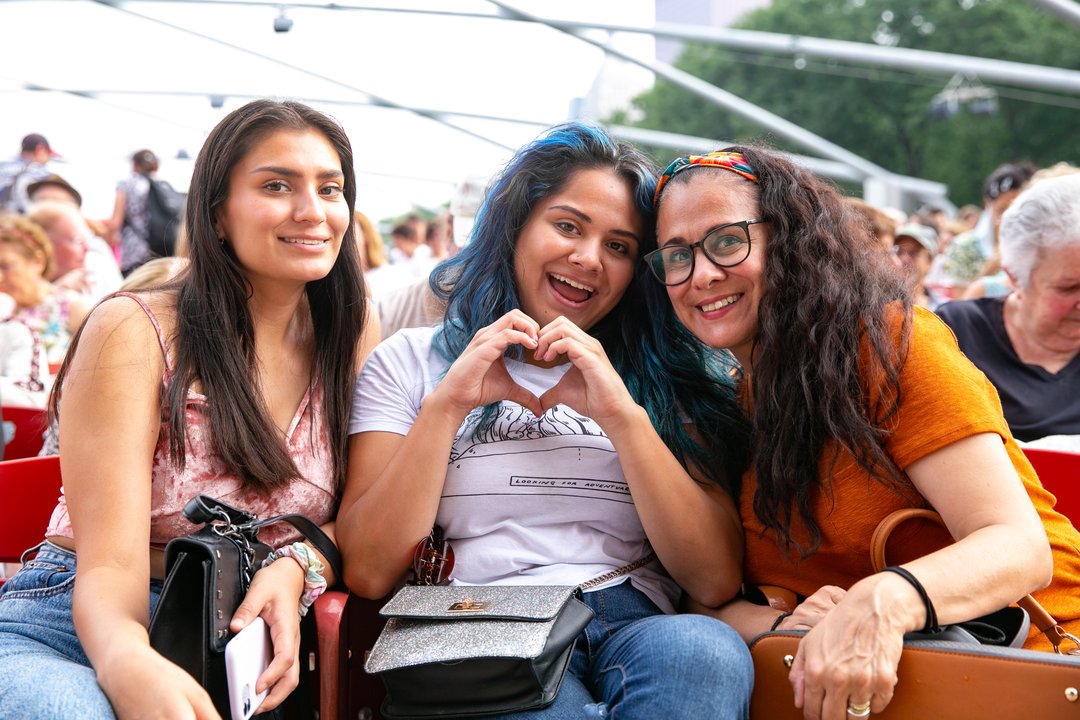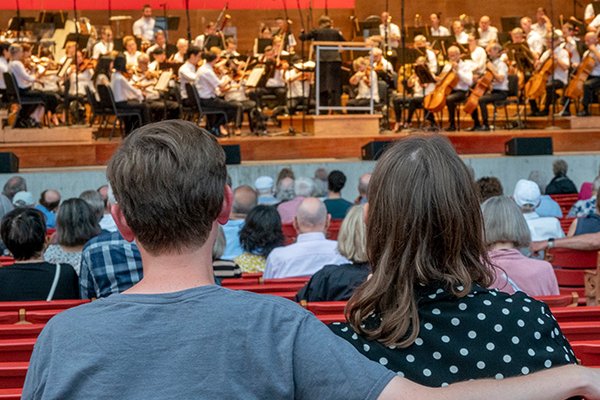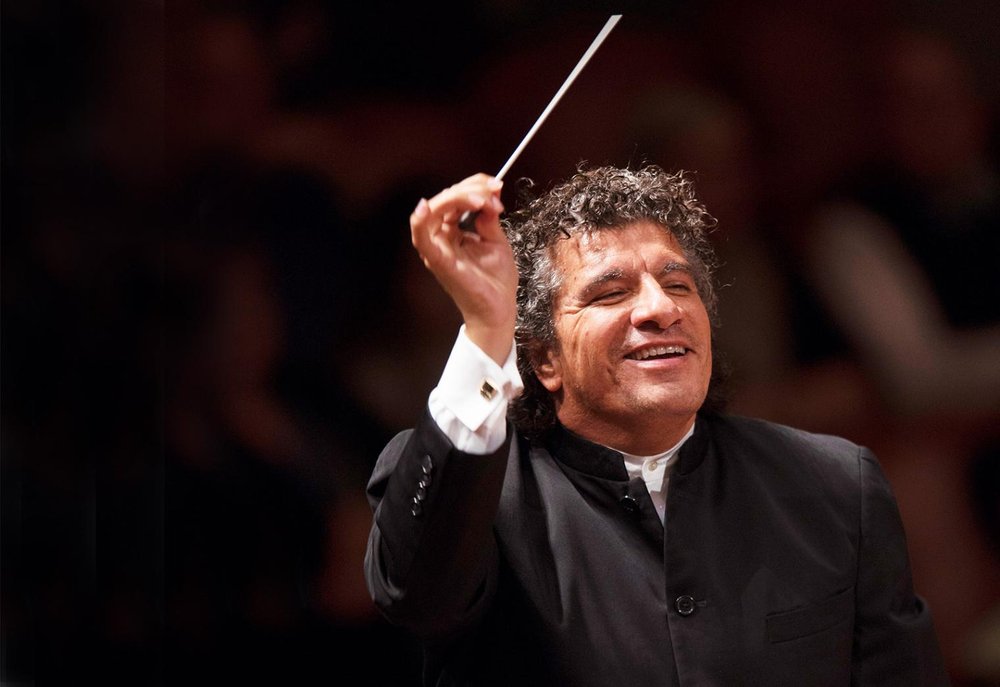
Mendelssohn Violin Concerto
Program
Adolphus Hailstork An American Port of Call (10 mins)
Felix Mendelssohn Violin Concerto (26 mins)
Allegro molto
Andante
Allegro non troppo – Allegro molto vivace
Leonard Bernstein Symphonic Suite from On the Waterfront (19 mins)
Andante (with dignity)—Presto barbaro
Adagio—Allegro molto agitato—Alla breve
Andante largamente—More flowing—Lento
Moving forward—Largamente—Andante come prima
Allegro non troppo, molto marcato—Poco più sostenuto
A tempo (Poco più sostenuto)
Featuring
Program Notes
Adolphus Hailstork (b. 1941)
An American Port of Call (1984)
Scored for: three flutes including piccolo, two oboes, two clarinets, three bassoons including contrabassoon, four French horns, three trumpets, three trombones, tuba, timpani, percussion, piano, and strings
Performance time: 10 minutes
First Grant Park Orchestra performance
Born in Rochester, New York, composer Adolphus Hailstork has called Virginia home since 1977. He earned his bachelor’s degree from Howard University before studying under the renowned composition teacher Nadia Boulanger at the American Conservatory in Fontainebleau during the summer of 1963. Hailstork continued his studies at the Manhattan School of Music and later earned his PhD from Michigan State University following his service in the US Armed Forces in Germany. He moved to Virginia to teach at Norfolk State University and later joined Old Dominion University, also in Norfolk, where he is an Eminent Scholar and Professor Emeritus of Music.
Norfolk and the surrounding region served as inspiration for Hailstork’s An American Port of Call. Established in 1682, Norfolk lies at the mouth of the James and Elizabeth rivers and the Chesapeake Bay and is adjacent to the Atlantic Ocean. Given its strategic location, it has a long history as a transportation and military hub and is home to the world’s largest naval base. When the Virginia Symphony Orchestra commissioned Hailstork to write a new piece to open the 1985 season, Hailstork looked to Norfolk’s bustling waterfront—specifically, the annual Harborfest, which features navy exhibits and the Parade of Sail featuring international tall ships.
Hailstork is concise in his description of the piece: “The concert overture, in sonata-allegro form, captures the strident (and occasionally tender and even mysterious) energy of a busy American port city.” After an exuberant opening gesture in the winds and strings, the horns, trumpets, and trombones play a rising fanfare figure in stacked minor seconds, evoking the clash of ship horns echoing across the water. These parallel dissonances, combined with frequent syncopations and scurrying sixteenth notes, heighten the sense of busyness and perpetual motion, while touches of the blues and jazz place the city firmly within America.
Felix Mendelssohn (1809–1847)
Concerto in E minor for Violin & Orchestra, op. 64 (1844)
Scored for: two flutes, two oboes, two clarinets, two bassoons, two French horns, two trumpets, timpani, strings, and solo violin
Performance time: 26 minutes
First Grant Park Orchestra performance: August 29, 1936; Richard Czerwonky, conductor and violin
Joseph Joachim, a protégé of Felix Mendelssohn and one of the most renowned violinists of the 19th century, hailed Mendelssohn’s Violin Concerto as one of the four great German violin concertos, alongside those by Beethoven, Brahms, and Bruch. To Joachim, Mendelssohn’s concerto was “the most inward, the heart’s jewel.” Considering the amount of time and care Mendelssohn put into it, it is no wonder.
Mendelssohn first wrote to violinist Ferdinand David in 1838, saying he wanted to write him a concerto: “One in E minor runs through my head, the beginning of which gives me no peace.” David, as well as being Mendelssohn’s boyhood friend, was the concertmaster of the Leipzig Gewandhaus Orchestra, of which Mendelssohn was music director. Although Mendelssohn was an accomplished violinist as a child, it was no longer his main instrument. Ever the perfectionist, Mendelssohn sought David’s advice throughout the protracted composition process, sending sketches and letters asking about the particulars of the solo violin part. His desire to get it just right, combined with his busy schedule and frequent bouts of ill health, delayed the concerto’s completion. Although he had worked on it steadily for six years, Mendelssohn only found the tranquility he needed to finish it while on vacation in the spa town of Soden in the summer of 1844. David premiered the work with the Gewandhaus Orchestra on March 13, 1845, with Danish composer Niels Gade on the podium, as Mendelssohn was again beset by illness.
This concerto would mark Mendelssohn’s last. Although he did write a concerto for violin and string orchestra at the age of 13 and a double concerto for piano and violin at 14, the Violin Concerto in E minor, Op. 64, stands alone as his only mature concerto for the instrument. Between his first attempt at 13 and this final offering, Mendelssohn had mastered the rules such that he could break them with authority. A few features set this concerto apart from its contemporaries. First, in lieu of a typical orchestral introduction, the soloist enters almost immediately with the elegiac opening theme that had so tormented Mendelssohn. Next, the cadenza in the first movement is placed not before the coda, as would be expected, but nearer the middle, after the development. Finally, Mendelssohn connects all three movements. After the final cadence of the Allegro molto appassionato, a single bassoon note hangs over, out of which the Andante gradually emerges. Mendelssohn then links the Andante and the finale with a brief intermezzo for solo violin and strings, almost like a recitative before an aria. Mendelssohn is said to have composed these musical bridges to discourage clapping between the movements, which breaks up the musical flow. It is partially thanks to him that holding one’s applause until the end of a multi-movement work is customary today. Because of these innovative structural choices, Mendelssohn’s Violin Concerto unfolds like one musical thought, which seamlessly evolves from the soloist’s opening plea, through to the song-like Andante and sparkling finale.
Leonard Bernstein (1918–1990)
Symphonic Suite from On the Waterfront (1955)
Scored for: three flutes including piccolo, two oboes, four clarinets including bass clarinet, three bassoons including contrabassoon, four French horns, three trumpets, three trombones, tuba, timpani, percussion, harp, piano, alto saxophone, and strings
Performance time: 23 minutes
First Grant Park Orchestra performance: July 1, 1967; Samuel Krachmalnick, conductor
Given his success on Broadway, it may come as a surprise that Leonard Bernstein only wrote one film score across his varied career—and he almost turned down the opportunity. When film producer Sam Siegel approached him about scoring Elia Kazan’s On the Waterfront, Bernstein was initially hesitant, largely because Kazan had just been embroiled in controversy. In 1952, Kazan had been called to testify before the House Un-American Activities Committee and had named eight fellow members of the Community Party. Those who were outed during the “Red Scare” were ostensibly blackballed from Hollywood, while “squealers” like Kazan also faced ostracization. Nevertheless, when Bernstein saw a rough cut of the film, which stars Marlon Brando, he was convinced. “The atmosphere of talent that this film gave off was exactly the atmosphere in which I love to work and collaborate,” he said.
With clear parallels to Kazan’s own circumstances, On the Waterfront was the director’s attempt to rehabilitate his reputation. The film tells the story of Terry Malloy, a dockworker in Hoboken, New Jersey, who gets entangled with the mob that controls the longshoreman’s union. Terry eventually risks his skin by testifying against the union boss, Johnny Friendly, after the mob kills Terry’s brother. Along the way, Terry falls in love with Edie, the sister of another dockworker who had been murdered after threatening to testify against the corrupt union officials.
Bernstein spent three months in Los Angeles in the spring of 1954 fully immersing himself in the craft of film scoring. Ultimately, Kazan decided only to use 35 minutes of music across the 107-minute film—a decision that understandably rubbed Bernstein the wrong way and turned him off Hollywood for good. So, the following year, Bernstein reclaimed artistic control by turning his music from On the Waterfront into a symphonic suite. In the suite, the score’s three main musical themes undergo a transformation that mirrors the chronology of the film. First, there is Terry’s theme, lonely and stoic, introduced by the solo French horn. Next comes the waterfront theme, the violence of the mob and grittiness of the city depicted by a wild onslaught of percussion and an alto sax solo that “bleats out a tugging, almost spastic, motive of pain,” Bernstein said. Finally, the flute introduces the love theme, reminiscent of Aaron Copland in its poignant simplicity, which eventually becomes entwined with Terry’s theme.
—Katherine Buzard
Artistic Leadership
Support The Festival
Violin I
Jeremy Black, concertmaster
Vacant, assistant concertmaster
Trista Wong
Zulfiya Bashirova
Jennifer Cappelli
Injoo Choi
Dima Dimitrova
Erica Hudson
Hyewon Kim
Matthew Lehmann
Jayna Park
Rika Seko
Karen Sinclair
Bonnie Terry
Krzysztof Zimowski
Violin II
Liba Shacht, principal
Vacant, assistant principal
Ying Chai
Ran Cheng
Karl Davies
Likai He
Ann Lehmann
Laura Miller
Cristina Muresan
Kjersti Nostbakken
Irene Radetzky
Jeanine Wynton
Thomas Yang
Viola
Terri Van Valkinburgh, principal
Yoshihiko Nakano, assistant principal
Elizabeth Breslin
Beatrice Chen
Amy Hess
Rebecca Swan
Chloé Thominet
Cello
Walter Haman, principal
Peter Szczepanek, assistant principal
Calum Cook
Larry Glazier
Steven Houser
Eric Kutz
Eran Meir
Double Bass
Colin Corner, principal
Peter Hatch, assistant principal
Andrew Anderson
Christian Luevano
Samuel Rocklin
Chunyang Wang
Chris White
Flute
Vacant, principal
Alyce Johnson
Jennifer Lawson, assistant principal
Piccolo
Jennifer Lawson
Oboe
Mitchell Kuhn, principal
Vacant
Anne Bach, assistant principal
English Horn
Anne Bach
Clarinet
Dario Brignoli, principal
Trevor O’Riordan, assistant principal
Besnik Abrashi
Bass Clarinet
Besnik Abrashi
Bassoon
Eric Hall, principal
Nicole Haywood Vera Tenorio, assistant principal
Vacant
Contrabassoon
Vacant
Horn
Vacant, principal
Stephanie Blaha, assistant principal
Neil Kimel
Brett Hodge
Paul Clifton
Trumpet
David Gordon, principal
Mike Brozick
Vacant, assistant principal
Vacant
Trombone
Daniel Cloutier, principal
Jeremy Moeller, assistant principal
Bass Trombone
Alexander Mullins
Tuba
Andrew Smith, principal
Timpani
Daniel Karas, principal
Josh Jones, assistant principal
Percussion
Josh Jones, principal
Vacant, assistant principal
Doug Waddell
Harp
Kayo Ishimaru-Fleisher, principal
Keyboards
Christopher Guzman
Orchestra Librarian
Eliza Bangert, principal
Grant Park Chorus
* denotes leave-of-absence † 2025 Vocal Fellow
Laura Lynch Anderson
Kristina Bachrach
Madalynn Baez
Megan E. Bell
Alyssa Bennett
Tamara Bodnar
Kylie Buckham
Anna Joy Buegel
Laura Bumgardner
Katherine Buzard
Bethany Clearfield
Nathalie Colas
Carolyne DalMonte
Megan Fletcher
Kaitlin Foley
Saira Frank
Julia Frodyma
Katherine Gray-Noon
Kimberly Gunderson
Alexandra Ioan
Alexandra Kassouf
Darlene Kelsey
Olivia Knutsen
Marybeth Kurnat
Katelyn Lee
Kyuyim Lee+
Rosalind Lee
Veronica Mak
Hannah Dixon McConnell
Marie McManama
Kathleen Monson
Susan Nelson
Evangeline Ng
Máire O'Brien
Alexandra Olsavsky
Laura Perkett
Angela Presutti Korbitz
Alexia Rivera
Veronica Samiec
Emily Sinclair
Molly Snodgrass
Tiana Sorenson
Christine Steyer
Sarah van der Ploeg*
Lydia Walsh-Rock
Sherry Watkins
Emily Amesquita
Melissa Arning
Christina Bernardoni
Angela Born
Bethany Brewer
Julie DeBoer
Leah Dexter
Katrina Dubbs
Stacy Eckert
Margaret Fox
Catarine Hancock
Ruth Ginelle Heald
Sophia Heinz
Miya Higashiyama
Carla Janzen
Amy Allyssa Johnson
Kathryn Kinjo Duncan
Amanda Koopman
Anna Laurenzo
Jeannette Lee
Thereza Lituma
Chelsea Lyons
Victoria Marshall
Jessica McCarthy
Quinn Middleman
Ella Peters
Sarah Ponder
Emily Price
Stephanie Schoenhofer
Suzanne A. Shields
Marissa Simmons
Cassidy Smith
Aidan Spencer
Alannah Spencer
Margaret Stoltz
Carolyn Sundlof Boudreau
Gabrielle Timofeeva López
Elizabeth Vaughan
Corinne Wallace-Crane
A.J. Wester
Debra Wilder
Isabel Yang+
Charles Anderson
Enrico Giuseppe Bellomo
Justin Berkowitz
Madison Bolt
Hoss Brock
Steven Caldicott Wilson
Opal Clyburn-Miller+
John J. Concepción
Micah Dingler
Jared V. Esguerra
Alec Fore
Ace Gangoso
Klaus Georg
Tejas Gururaja
Paul Hunter
Garrett Johannsen
William Johnson
James Judd
Tim Lambert
Tyler Lee
Stephen D. Noon
Marcos Ochoa
Brett Potts
Nicholas Pulikowski
Peder Reiff
Samuel Rosner
Matthew W. Schlesinger
Joe Shadday
Aaron Short
Brian Skoog
Michael St. Peter
Ryan Townsend Strand
Alan Taylor*
Sean J. Watland
Nate Widelitz
Walter Aldrich
Evan Bravos
Matthew Brennan
Michael Cavalieri
Ryan J. Cox
Ed Frazier Davis
Lifan Deng
Matthew Dexter+
Chris DiMarco
Christopher Filipowicz
Dimitri German
Dominic German
David Govertsen
Spencer Greene
Brian Hupp
Jan Jarvis
Jess Koehn
Eric Miranda
Ian Morris
Ian Murrell
John E. Orduña
Wilbur Pauley
Douglas Peters
Jackson Pierzina
Martin Lowen Poock
Ian Prichard
Dan Richardson
Stephen Richardson
Benjamin D. Rivera
Scott Uddenberg
Schyler Vargas
Vince Wallace
Aaron Wardell
Ronald Watkins
Jonathon Weller
Peter Wesoloski
Jonathan Wilson
Chuck Foster
John Goodwin
Kyuyim Lee
Isabel Yang
Opal Clyburn-Miller
Matthew Dexter
